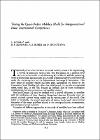| dc.contributor.author | Iutaka, S. | |
| dc.contributor.author | Bloomer, B.F. | |
| dc.contributor.author | Burke, R.E. | |
| dc.contributor.author | Wolowyna, O. | |
| dc.date.accessioned | 2014-04-24T21:19:19Z | |
| dc.date.available | 2014-04-24T21:19:19Z | |
| dc.date.issued | 1975 | |
| dc.identifier.citation | S. Iutaka, B.F. Bloomer, R.E. Burke, O. Wolowyna, 'Testing quasi-perfect mobility model for intergenerational data - international comparisons', Economic and Social Research Institute, Economic and Social Review, Vol. 6, No. 2, 1975, 1975, pp215-236 | |
| dc.identifier.issn | 0012-9984 | |
| dc.identifier.uri | http://hdl.handle.net/2262/69025 | |
| dc.description.abstract | The study of social stratification and social mobility seems to be experiencing a revival of interest in recent years. The first studies on a national level were carried out in the decade following World War II, with the pioneering work of David Glass and associates. A series of national surveys soon followed, under the encouragement of the International Sociological Association. This early phase of mobility studies has been aptly summarised by Miller in his Comparative Social Mobility. After this initial period, the variable occupational status, social class, or the like, became an intrinsic part of most sociological investigations, but the interest in social mobility subsided. | |
| dc.language.iso | en | |
| dc.publisher | Economic & Social Studies | |
| dc.relation.ispartofseries | Economic and Social Review | |
| dc.relation.ispartofseries | Vol. 6, No. 2, 1975 | |
| dc.subject | Social mobility | |
| dc.subject | Social stratification | |
| dc.title | Testing quasi-perfect mobility model for intergenerational data - international comparisons | |
| dc.type | Journal article | |
| dc.status.refereed | Yes | |
| dc.publisher.place | Dublin | |
| dc.rights.ecaccessrights | OpenAccess | |
| dc.format.extentpagination | pp215-236 | |




